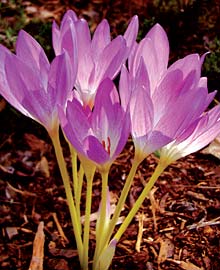Right about the time I’m getting sick of summer and longing to feel just a little nip in the air, up pops a pink or white bud, seemingly out of nowhere, to prop up my sagging spirits. This drought and the endless rounds of watering have gotten me down, but the colchicums don’t care if it hasn’t rained all summer. They’re ready to spice things up and leave you feeling a bit topsy-turvy. After all, it is September, and everything was supposed to be up months ago, wasn’t it?

That’s the great thing about gardening: A surprise is always lurking behind the hedge, just when you really need it. Most of this season’s surprises seem to come in the form of bulbs or corms, which we tend to associate with the freshness of spring rather than the doldrums of late summer. Colchicums come in a number of species and varieties. Most are some shade of lavender/pink; a few are white, and one, called ‘Waterlily’, produces double blooms. All are a cinch to grow, requiring only a well-drained site and some sun. The hardest thing about them is remembering where they are so you don’t cut them in half when planting something else.
Colchicums aren’t the only garden surprise around this time of year. Their first cousins, the autumn-flowering crocuses, also pop up with no warning. But I’ve found the colchicums a better investment, since they’re rich in a poisonous alkaloid that keeps the crocus-loving chipmunks at bay. The colchicums also seem to hold up much better than the flimsy, short-lived crocus flowers.
Another flower that seems to come out of nowhere is the aptly named surprise or magic lily. It too spends the summer dormant and sends up its flowers when least expected. The most commonly available species, Lycoris radiata, is very showy, with bright-red flowers and wonderful, prominent stamens. They are also excellent cut flowers and make an exceptional, elegant bouquet.
For those who like their flowers more subtle, late summer is the season for the ivy-leafed cyclamen, whose pink (or, rarely, white) flowers also emerge before the foliage. While not as showy as the colchicum or lycoris, this dainty cyclamen is for those with the most refined taste. If you know only their more garish hothouse cousins, you’ll be in for a treat if you seek out the unhybridized wildlings. Like shooting stars, which are also in the primrose family, the ivy-leafed cyclamen’s petals flare back and have a little twist to them. After they’re pollinated, the flower stalk coils up like a spring, bringing the seedpod down flat on the ground, where it rests until the seeds mature the following summer. It’s a neat little detail that appeals to children—the kind of thing that helps them engage with the plant world and perhaps sparks an interest in gardening.
The flowers are charming, but the real tour de force is the foliage, which is just now emerging in my garden. For quality of pattern, the leaves of this cyclamen are some of the finest in the entire plant world. Like the proverbial snowflake, each plant is different, with varying shades of green, silver and gray forming extraordinary, kaleidoscopic figures. They persist all through the winter, when such splendor is especially welcome, not disappearing until late spring. If you have the room or the budget for only a few, place them where they can be viewed up close, for their charm is of the diminutive sort. For those with more ample means, they make a wonderful ground cover beneath a deciduous tree, tending to do well even with lots of root competition.
Hillsborough, N.C., resident Nancy Goodwin of Montrose fame began growing many species of seedling cyclamens 20 years ago, and she now has a huge sweep of them under a mature Magnolia tripetala. The effect is absolutely enchanting. In Turkey, wild cyclamen corms used to be harvested by the ton, but most bulb outlets now offer seed-raised corms. Although they’re usually smaller, they acclimate much faster and don’t deplete wild populations. While the colchicums and lycoris give us a grand but fleeting display, the cyclamen provide three seasons worth of pleasure. It’s hard to do better than that.
[Garden designer Edmund Taylor lives in the wilds of Madison County. He can be reached at swallowtailgardendesigns@hughes.net]



Before you comment
The comments section is here to provide a platform for civil dialogue on the issues we face together as a local community. Xpress is committed to offering this platform for all voices, but when the tone of the discussion gets nasty or strays off topic, we believe many people choose not to participate. Xpress editors are determined to moderate comments to ensure a constructive interchange is maintained. All comments judged not to be in keeping with the spirit of civil discourse will be removed and repeat violators will be banned. See here for our terms of service. Thank you for being part of this effort to promote respectful discussion.